![]()
![]()
![]()
Use LEFT and RIGHT arrow keys to navigate between flashcards;
Use UP and DOWN arrow keys to flip the card;
H to show hint;
A reads text to speech;
28 Cards in this Set
- Front
- Back
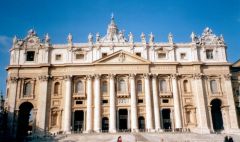
|
Carlo Maderno, east façade of Saint Peter’s, Vatican City, Rome, Italy, 1606-1612
Description:re done add horse shoe to entrance , expanding into plaza and vatican courtyard Stylistic features: can hold up to a half a million people, altar acts as a shrine and canopy over the grave of saint peter, buried under basilica, dramatic action typical of baroque Significance:colonnade like open arms welcome people back to the church, key hole, st peter holds the key to heaven? chapel? buried underneath |
|
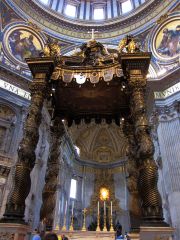
|
ID: Gianlorenzo Bernini, Baldacchino, Saint Peter's, Vatican City, Rome, Italy, 1624-1633
Stylistic pd./culture: Baroque- Italy Subject Ico.: Marks the high altar and the tomb of Saint Peter. The columns create a visual frame for the sculpture representing Saint Peter's throne Decorative elements represent the power of the Catholic church Angels stand guard at the upper corners of the canopy The orb and cross symbolize the Church's triumph Style/Techn.: canopy-like structure, dramatic, spiral columns, lost-wax process, chasing, bronze, brass, wood Sign./Func./Purp.: placed under Giacomo della Porta's dome. The four spiral columns are Baroque versions of ancient baldacchino columns over the same spot in Old Saint Peter's (invokes the past to reinforce the primacy of the 17th century Roman Catholic Church. |
|
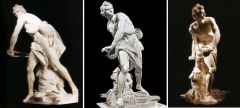
|
Bernini, David, 1623
Materials/medium: marble Size/scale: 5 7 Subject: David Stylistic features:most dramatic, swinging action, resembles Hellenistic period harp at feet symbolize his role as musician, Bernini idealized self portrait is in David's face, in the round, different angles at different places Function & significance:influence of Greek Hellenistic |
|
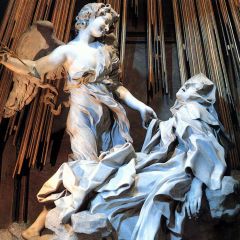
|
Bernini, Ecstasy of Saint Teresa, Cornaro chapel, Santa Maria della Vittoria, Rome, Italy, 1645-1652
Materials/medium:marble Size/scale: Subject: teresa and angel Stylistic features: being pierced by god, light from window abpove work gives heavenly feeling to sculpture, figures float adding to dramatics, skin is high gloss, feathers of angels are rough, exaustion is consistent with her diary, dramatic stage like setting Function religious, power, counter reformation, architecture, sculpture and painting |
|

|
Bernini, Cornaro chapel, Santa Maria della Vittoria, Rome, Italy, 1645-1652
Description: Architectural features: Sculptural features: Function & significance: Francesco Borromini, façade of San Carlo alle Quattro Fontane, Rome, Italy, 1638-1641 Description & architectural features:square with four fountains facade is higher than the rest of the building walls created sculpturally avoided colors interior chapels merge into shared space Sculptural & ornamental features: walls created sculpturally, dome makes eye move within it greek cross plan Function & significance: Borromini, plan of San Carlo alle Quattro Fontane, Rome, Italy, 1638-1641 Description & significance:greek cross plan Borromini, San Carlo alle Quattro Fontane (view into dome), Rome, Italy, 1638-1641 Description:makes eye move |
|
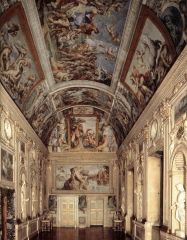
|
Annibale Carracci, Loves of the Gods, ceiling frescoes in the gallery, Palazzo Farnese, Rome, Italy, 1597-1601
Materials/medium: Size/scale: Subject: Stylistic features:everything is framed looks like pictures within pictures, rich colors, figures overlap and take up the same space Function & significance:celebrate wedding |
|

|
Caravaggio, Calling of Saint Matthew, ca. 1597-1601
Materials/medium: oil on canvas Size/scale: Subject: Stylistic features: chiaroscuro dramatic light, tenebrism, fingers and hand like michelangelo creation of man, two light sources, christ gesture is similar to adams, dressed in common baroque fashion, stage for figures to sit and stand, slight halo on jesus head Function & significance:naturalistic approach to baroque |
|
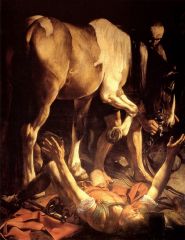
|
ID: Caravaggio, Conversion of Saint Paul, ca. 1601. Oil on canvas, 7'6" X 5'9". Cerasi chapel, Santa Maria del Popolo, Rome.
Stylistic pd./culture: Italian Baroque Subjet Ico.: Represents the saint-to-be bat the moment of his conversion Designed for its specific location on the chapel wall Resembles a stage production The light shining down on Paul = the light of divine revelation converting him to Christianity The viewer becomes a witness Style/Technique: eloquence, humanity, chiaroscuro, dramatic, tenebrism,realistic Sign./Func./Purp.: Painted for the Cerasi chapel in Santa Maria del Popolo |
|
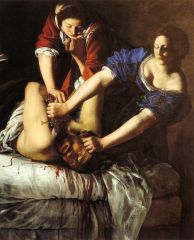
|
Artemisia Gentileschi, Judith Slaying Holofernes, ca. 1614-1620
Materials/medium:oil on canvas Size/scale: Subject: Stylistic features:dramatic lighting, Function & significance:influenced by Caravaggio chiaroscuro dramatic light, tenebrism |
|
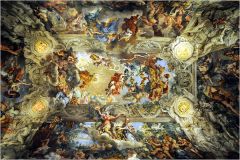
|
Pietro da Cortona, Triumph of the Barberini, ceiling fresco in the Gran Salone, Palazzo Barberini, Rome, Italy, 1633-1639
Description & subject:ceiling fresco, symbols of patrons, figure move easily within the space, subdivided by architectural, illusionistic |
|

|
Velázquez, Las Meninas (The Maids of Honor), 1656
Materials/medium:oil on canvas Size/scale: Subject:group portrait Stylistic features:looks at the view while painting, wears cross of royal orders, hung in study, the king and queen reflect in the mirror alternating dark and light, real, mirrored, and picture space to elevate both himself Function & significance: |
|
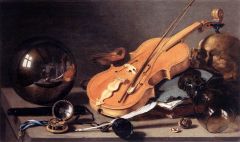
|
Pieter Claesz, Vanitas Still Life, 1630s
Medium/materials:oil on canvas Size/scale: Subject: Stylistic features:cracked walnut, skull, glass and mirror symbolize the quickness of life Function & significance: make the most out of life, passage of time, here and before you know it you can be gone, life is short and you must make the most out of it |
|
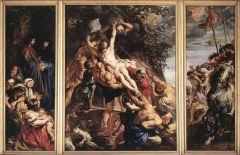
|
Peter Paul Rubens, Elevation of the Cross, from Saint Walburga, Antwerp, 1610
Medium/materials:oil on canvas Size/scale: Subject:christ on cross Stylistic features:sculptural qualities in figures, dramatic chiaroscuro, color and texture like the venetians, theatrical presentation, dynamic energy and unleashed passion of the baroque, continuous narrative across three panels, influenced by laocoon and sons, triptych , foreshortened, emotional tension, emotions Function & significance:most sought after artist at the time |
|
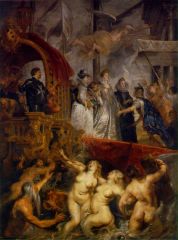
|
Rubens, Arrival of Marie de’ Medici at Marseilles, 1622-1625
Medium/materials:oil on canvas Size/scale: Subject:maria arrives in france Stylistic features:splendor of baroque imagery reinforced right to rule, sumptuous full-fleshed women,4 years to complete, intensity of color, movement, allegories assist in telling the story and mix freely with historical figures, personification of France, propaganda, shows queens fame and power Function & significance:propaganda |
|
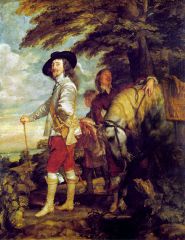
|
Anthony Van Dyck, Charles I Dismounted, ca. 1635
Medium/materials:oil on canvas Size/scale: Subject: Stylistic features:portrait, regal stance, short but looking down at us, horse bows down to him, comp. looks smaller than him to make him look larger and bigger, off center, a-symmetrical, venetian landscape, engages viewer looks directly at us Function & significance:pupil of rubens, power propaganda, influence |
|

|
Frans Hals, Archers of Saint Hadrian, ca. 1633
Medium/materials:oil on canvas Size/scale: Subject:portrait of dutch middle class Stylistic features:spontaneous and light brush strokes. individuals, split in canvas, two different social structures, personalized faces of individuals, unity of attire, moods, moments, expressions, poses,personalities Function & significance: |
|
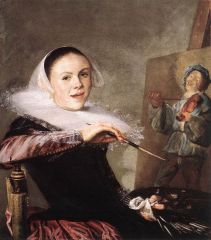
|
Judith Leyster, Self-Portrait, ca. 1630
Materials/medium:oil on canvas Size/scale: Subject:self portrait Stylistic features:impasto painting, strong brush strokes, confidence,quick smile,relaxed pose, self confident, not wearing traditional artist smock, comic relief with jester Function & significance:student of hals |
|
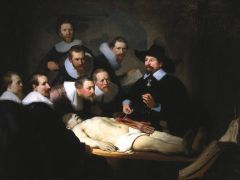
|
Rembrandt van Rijn, Anatomy Lesson of Dr. Tulp, 1632
Materials/medium:oil on canvas Size/scale: Subject:medical lesson Stylistic features:tulp seating in a place of honor, hands show he's an educator, each student has individual poses and expressions reflecting their interest, horizontal placement of cadaver, foreshortened, academic painting Function & significance: first group portrait, anatomy lesson, help educate and train |
|

|
Rembrandt van Rijn, The Company of Captian Frans Banning Cocq (Night Watch), 1642
Materials/medium: Size/scale:12 x 14 Subject: Stylistic features:individual figures, light and dark, girl is mascot, claws of chicken symbolize militia Function & significance: payed for spot on painting either half a figure or whole figure, payed for to put in city hall |
|
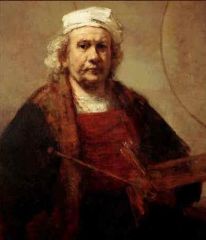
|
Rembrandt van Rijn, Self-Portrait, 1659-1660
Materials/medium:oil on canvas Size/scale: Subject:self Stylistic features:penetrating gazes Function & significance:they captured his various emotions: suffering, dignified,weariness, satisfaction |
|
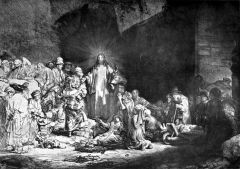
|
Rembrandt van Rijn, Christ with the Sick around Him, Receiving the Children (Hundred-Guilder Print), ca. 1649
Materials/medium:etching Size/scale: Subject:jesus feels the pain of the handicap Stylistic features:contrast of light and dark, 2nd cast of light on poor man on jesus tunic, humanity and humility of jesus preaching and blessing the blined, lame and young Function & significance:called 100 guilder print, payed a lot of money for print |
|
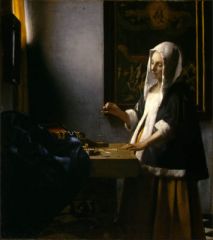
|
Jan Vermeer, Women Holding a Balance, ca 1666
Materials/medium:oil on wood Size/scale: Subject:women holding balance Stylistic features:mirror on wall symbolize vanity, picture in back symbolize god, Function & significance:used camera obscura to paint |
|
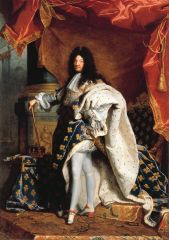
|
Hyacinthe Rigaud, Louis XIV, 1701
Materials/medium: oil on canvas Size/scale: Subject: Stylistic features: 63 years old but appears in coronation robe (still young), ballet dancer in youth, proud of legs, exposes them, short but heels make him look taller, red drape shows power and influence, Function & significance:major patron to the arts, no one permitted to turn back on painting, propaganda |
|

|
Claude Perrault, Louis Le Vau, and Charles Le Brun, east façade of the Louvre, Paris, France, 1667-1670
Description, architectural & stylistic features: vast park, transformed forest into a park, changing artwork, showings, formal gardens and informal, Function & significance: Aerial view of the palace and gardens, Versailles, France, begun 1669 Description, architectural & stylistic features:formal gardens and informal gardens Function & significance: Jules Hardouin-Mansart and Charles Le Brun, Galerie des Glaces (Hall of Mirrors), palace of Versailles, Versailles, France, ca. 1680 Description, architectural & stylistic features:mirrors extend the look of the building making it look larger and larger Function & significance: |
|
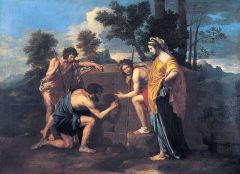
|
Nicolas Poussin, Et in Arcadia Ego, ca. 1566
Materials/medium:oil on wood Size/scale: Subject: Stylistic features: youth with foot on boulder resembles neptune, resembles roman times,” i too arcadia” female may be the spirit of death, shadow grim reaper, young medium and dead trees Function & significance: circle of life |
|
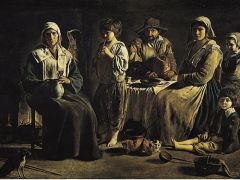
|
Louis Le Nain, Family of Country People, ca. 1640
Materials/medium: Size/scale: Subject:peasant family Stylistic features:life is hard , shows anguish and frustration of peasantry Function & significance: natural virtue of those who work the soil |
|
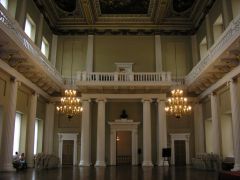
|
Inigo Jones, Banqueting House, Whitehall, London, England, 1619-1622
Description: Architectural features & style: french windows, engaged columns, one large room, balustrade roof, Function & significance:built for james the first |
|
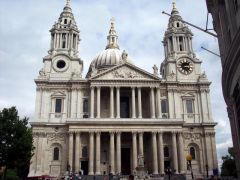
|
Sir Christopher Wren, west façade of Saint Paul’s Cathedral, London, England, 1675-1710
Description: Architectural features & style:superimposed paired columnar Function & significance:influenced colonial america |

